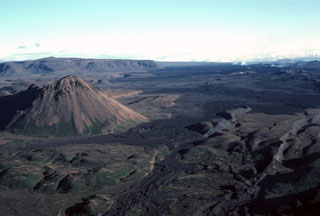Report on Krafla (Iceland) — December 1979
Scientific Event Alert Network Bulletin, vol. 4, no. 12 (December 1979)
Managing Editor: David Squires.
Krafla (Iceland) Minor deflation with little seismicity, then inflation resumes
Please cite this report as:
Global Volcanism Program, 1979. Report on Krafla (Iceland) (Squires, D., ed.). Scientific Event Alert Network Bulletin, 4:12. Smithsonian Institution. https://doi.org/10.5479/si.GVP.SEAN197912-373080
Krafla
Iceland
65.715°N, 16.728°W; summit elev. 800 m
All times are local (unless otherwise noted)
"The relatively slow but steady inflation of Krafla was interrupted by a minor deflation event 3-10 December. This deflation was very slow and no volcanic tremor was observed. Inflation resumed on 10 December and on 15 December the previous ground level had been reached.
"The number of earthquakes in the vicinity of the magma chambers had increased gradually in November, but during the mini-deflation earthquake activity decreased to background levels. When the previous ground level was exceeded in the second half of December, the number of recorded earthquakes started to increase again. The largest, of estimated magnitude 4, took place on 3 January and was widely felt in the area."
Geological Summary. The Krafla volcanic system in the Northern Volcanic Zone (NVZ) of Iceland is about 100 km long, consisting of a fissure swarm and a central volcano with a 7 x 9 km caldera formed about 110,000 years ago that deposited a rhyolitic welded tuff. It has been moderately active in the Holocene, over three distinct eruptive periods; the current one has lasted about 2,800 years with six volcano-tectonic episodes, each with one or more basaltic fissure eruptions. Lava volumes (DRE) have been in the 0.1-1 km3 range. The Hverfjall and Ludent tuff rings east of Myvatn were erupted along the fissure system. Myvatn lake formed during the eruption of the older Laxarhraun lava flow from the Ketildyngja shield volcano of the Fremrinamur volcanic system about 3,800 years before present (BP); The present Myvatn lake is constrained by the roughly 2,000 years BP younger Laxarhraun lava flow from the Krafla volcanic system. The abundant pseudocraters that form a prominent part of the Myvatn landscape were created when the younger Laxarhraun lava flow entered the lake. The last eruption took place in 1975-1984 CE when nine small basaltic fissure eruptions produced 0.25 km3 of lava.
Information Contacts: K. Grönvold, NVI.

